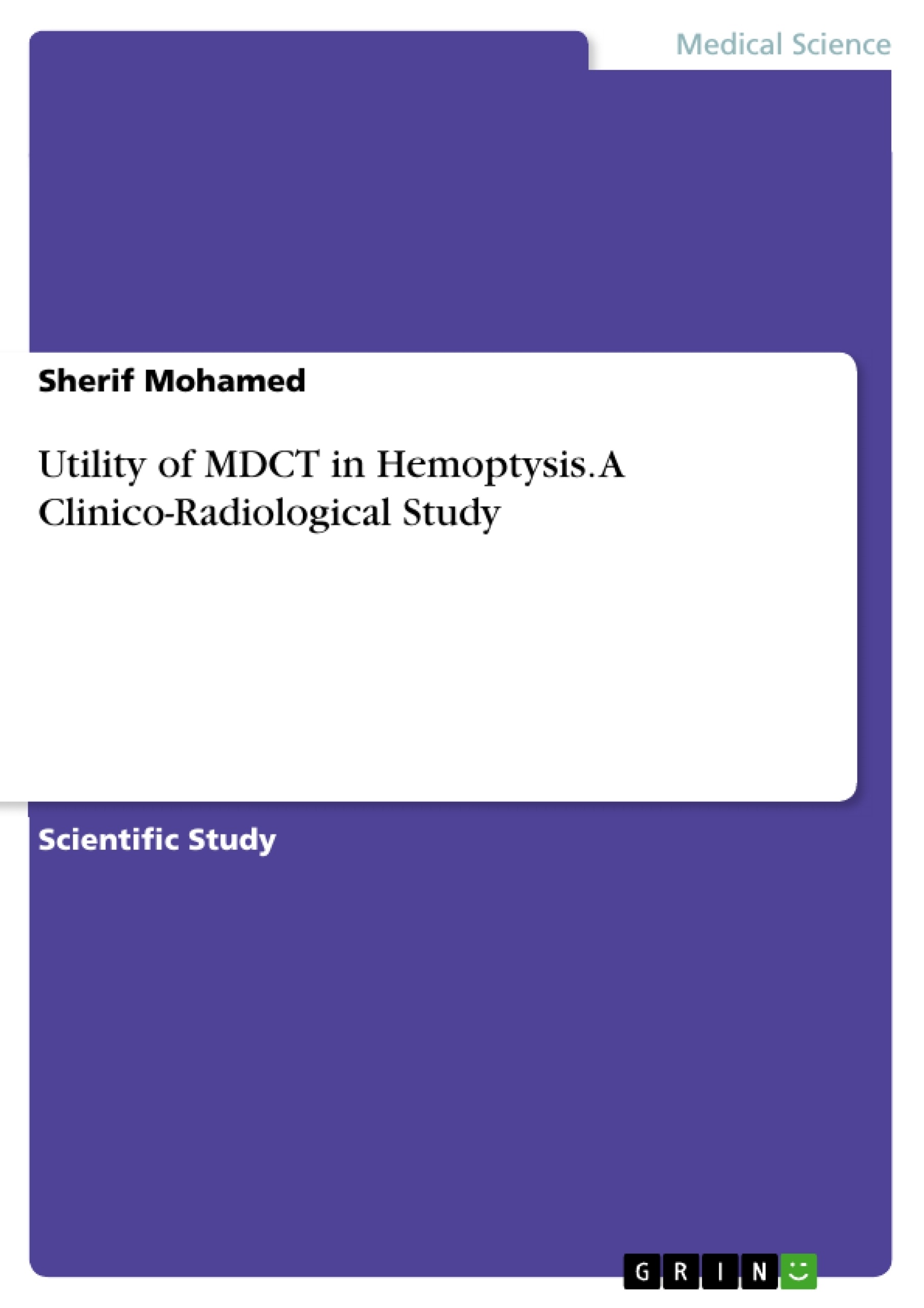Hemoptysis is defined as bleeding arising from the lower airways. Identifying the etiology of hemoptysis and classifying it in terms of the amount of blood expectorated as well as the rate of bleeding play a fundamental role in defining the timing, way and place of managing a patient with hemoptysis. There are multiple causes of hemoptysis, including airway diseases, parenchymal lung diseases, cardiovascular diseases, and others. However, no cause is identified in 15–30% of all cases, and is termed idiopathic or cryptogenic hemoptysis. In the majority of cases, the source of massive hemoptysis is the bronchial circulation. However, nonbronchial systemic arteries can be also a significant source. Imaging modalities pertinent to the evaluation of hemoptysis include chest radiography, computed tomography, and bronchial arteriography. Conditions such as bronchiectasis, chronic bronchitis, lung malignancy, tuberculosis, and chronic fungal infection are easily detected with conventional CT. Even, CT is superior to fiberoptic bronchoscopy in finding a cause of hemoptysis, its main advantage being its ability to show distal airways beyond the reach of the bronchoscope, and the lung parenchyma surrounding these distal airways. However, more recently, the development of multidetector row CT has provided a comprehensive, noninvasive method of evaluating the entire thorax. At the same time, the combined use of thin-section axial scans and more complex reformatted images allows clear depiction of the origins and trajectories of abnormally dilated bronchial or non-bronchial systemic arteries that may be the source of hemorrhage requiring embolization.
Inhaltsverzeichnis (Table of Contents)
- Introduction
- Review of the literature
- Chapter I: Anatomical Overview
- The Pulmonary arteries
- The pulmonary veins
- Chapter II: Pathophysiology of hemoptysis
- Clinical Significance
- Causes of Hemoptysis
- Physical Examination:
- Pathophysiology:
- Diagnostic modalities in hemoptysis:
- Chapter III: Multi-detector row CT & hemoptysis
- Multi–Detector Row CT Technique
- Data Manipulation and Image Interpretation
- Assessment of the Lung Parenchyma
- Assessment of Pulmonary and Systemic Vasculature Arteries
- Bronchial Arteries
- Nonbronchial Systemic Arteries
- Bronchial-to-Systemic Artery Communications
- Cryptogenic Hemoptysis
- Patients and Methods
- Patients
- Multidetector CT
- Results
- Case presentations
- Case 1
- Case 2
- Case 3
- Case 4
- Case 5
- Case 6
- Case 7
- Case 8
- Case 9
- Case 10
- Discussion
- Conclusions
Zielsetzung und Themenschwerpunkte (Objectives and Key Themes)
This clinical-radiological study aims to evaluate the utility of Multi-Detector Row Computed Tomography (MDCT) in the diagnosis and management of hemoptysis, focusing on its ability to identify the site of bleeding and its vascular origin. The study also investigates the use of bronchial and pulmonary angiographic techniques in conjunction with MDCT.
- The utility of MDCT in the diagnosis and management of hemoptysis
- The role of bronchial and pulmonary angiography in conjunction with MDCT
- The anatomical and physiological characteristics of the pulmonary and bronchial vascular systems
- The diverse etiologies and pathophysiology of hemoptysis
- The different approaches to identifying and managing hemoptysis, including clinical assessment, radiological techniques, and interventional procedures.
Zusammenfassung der Kapitel (Chapter Summaries)
Chapter I provides a comprehensive anatomical overview of the pulmonary and bronchial vascular systems, highlighting the importance of understanding their interconnectedness and the role of bronchial arteries in supplying blood to the lungs. Chapter II delves into the pathophysiology of hemoptysis, exploring its clinical significance, common causes, and the mechanisms of bleeding. It also discusses various diagnostic modalities used in the evaluation of hemoptysis, including chest radiography, bronchoscopy, and MDCT. Chapter III focuses on the application of MDCT in the management of hemoptysis, particularly the use of MDCT angiography to identify and depict bronchial arteries, nonbronchial systemic vessels, and pulmonary vasculature that may be responsible for bleeding. This chapter emphasizes the advantages of MDCT angiography in guiding further therapeutic procedures. The "Patients and Methods" section outlines the study design, enrollment criteria, and methodology used to collect data from 52 patients with hemoptysis. The "Results" section presents the demographic data, clinical findings, and radiological results, highlighting the prevalence of various causes of hemoptysis and the effectiveness of MDCT in identifying the source of bleeding. "Case Presentations" provides detailed descriptions of 10 representative cases, illustrating the application of MDCT in the diagnosis and management of different types of hemoptysis. The "Discussion" section analyzes the study findings in relation to existing literature, comparing the results to previous studies and highlighting the significance of MDCT angiography in the management of hemoptysis. The "Conclusions" section summarizes the key findings of the study, emphasizing the value of MDCT angiography as a primary noninvasive imaging modality in the evaluation of patients with hemoptysis.
Schlüsselwörter (Keywords)
Hemoptysis, Multi-Detector Row Computed Tomography (MDCT), Bronchial arteries, Nonbronchial systemic arteries, Pulmonary vasculature, Angiographic techniques, Etiology, Pathophysiology, Diagnosis, Management, Interventional procedures, Arterial embolization.
- Chapter I: Anatomical Overview
- Quote paper
- Sherif Mohamed (Author), 2015, Utility of MDCT in Hemoptysis. A Clinico-Radiological Study, Munich, GRIN Verlag, https://www.grin.com/document/444917



